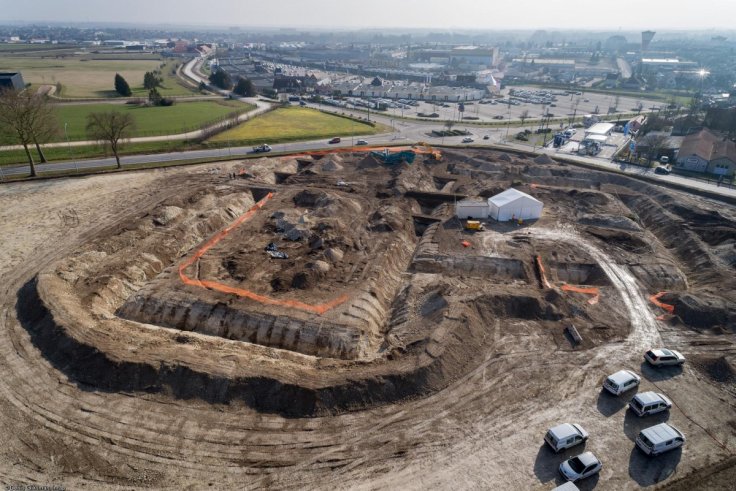
PHOTO: ibtimes.co.uk
LAVAU, FRANCE – two years ago, a small village in eastern France became famous when archaeologists first uncovered the 5th century BC tomb of a Celtic prince. Now, the researchers are beginning to finally unveil the secrets of the tomb.
The tomb rests in the heart of a small business industrial park. Archaeologists discovered it when they were asked to search the site and ensure no history would be lost in a new construction project. It’s a good thing that they did. After a few months of looking around, archaeologists discovered a large number of well-preserved Greek and Etruscan artifacts. The French state ruled it a historical site and ordered a more detailed investigation of the area.

PHOTO: ibtimes.co.uk
After more digging, the archaeologists found more and more artifacts in lower archaeological layers, dating all the way back to the 5th century BC, including jewelry and an impressive bronze cauldron. Upon digging further, they discovered the area’s most significant find to-date: the remains of an ancient Celtic prince laid to rest beside his chariot. Historians are now calling this find is one of the most important discoveries in all of France.
Over the past couple of years, using x-ray radiography and 3D photography, researchers have documented the artifacts. These methods allowed them to discover priceless information about how and when the artifacts were made, and learn about their state of conservation.
An Incredible Look Into the Ancient World

PHOTO: ibtimes.co.uk

PHOTO: ibtimes.co.uk
The research at Lavau has revealed just how intricate and beautiful these artifacts were when they were made.
The prince was found with a belt decorated with silver threads all woven together into Celtic motifs. It’s a unique object. No other object like it has ever been discovered in the world. The bronze cauldron they found at the site is decorated with the face of Dionysius – and demonstrates perfect mastery of smelting and engraving. The prince was buried with all sorts of golden jewelry, including beautiful bracelets and a Celtic torc signifying his social rank.
The artifacts uncovered also tell a story of trade and communication between ancient cultures – a pattern that is becoming increasingly prevalent in recent archaeological finds. A jar used to pour wine was buried with the prince that is made from Greek ceramic, decorated with gold Etruscan motifs, and silver Celtic designs. It’s physical proof of the cultural and economic interactions taking place between the Celtic and Mediterranean worlds during the 5th century.
During this period in history, the Greeks were fighting a war for their very existence against Persia at Thermopylae, Salamis Bay, and Marathon. For a brief time, the Greek city-states put away their differences and united against a common enemy. That clearly didn’t stop trade from happening, though. Greeks were famous for their bronze-work and iconic pottery. The Etruscans, on the other hand, were famous for their art and glossy black pottery. Finding artifacts from both cultures in this tomb tells us just how rich and important this Celtic prince really was. His pockets were deep, and he had hundreds of connections.
Research on the “Prince of Lavau” is expected to continue until 2019. The archaeologists working on the site hope to learn more about the prince’s identity and about the origins of the objects he was given to take with him into his afterlife. This find has already given us a vital look into life in ancient France, Greece, and Italy, and there’s still at least two more years of research to go!

